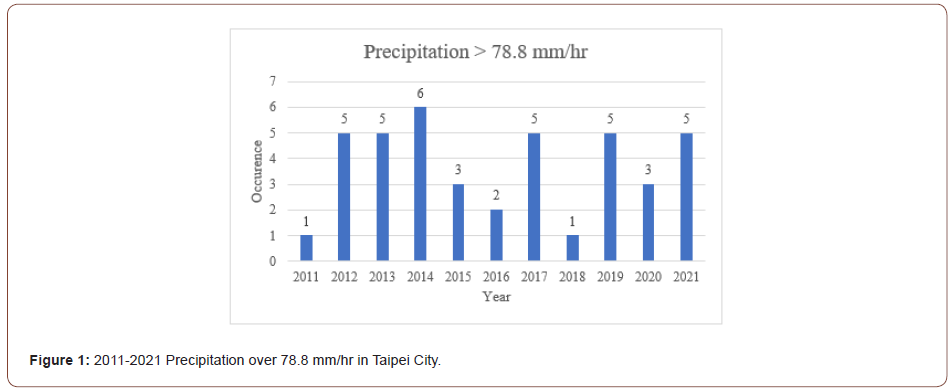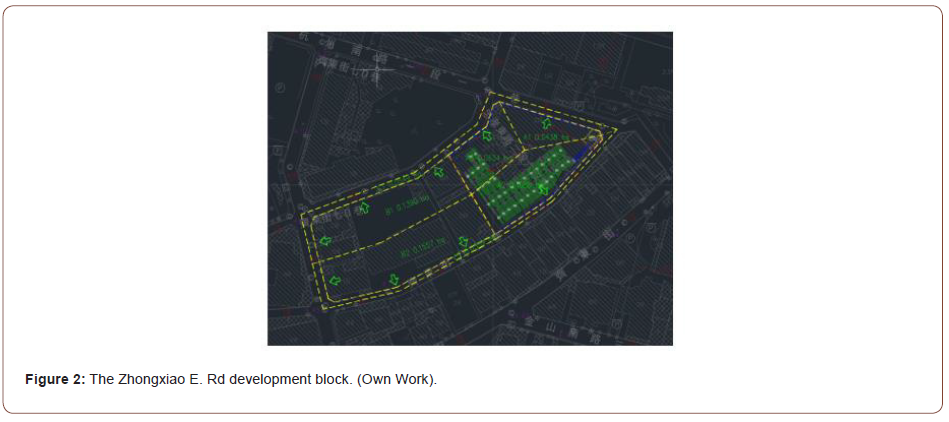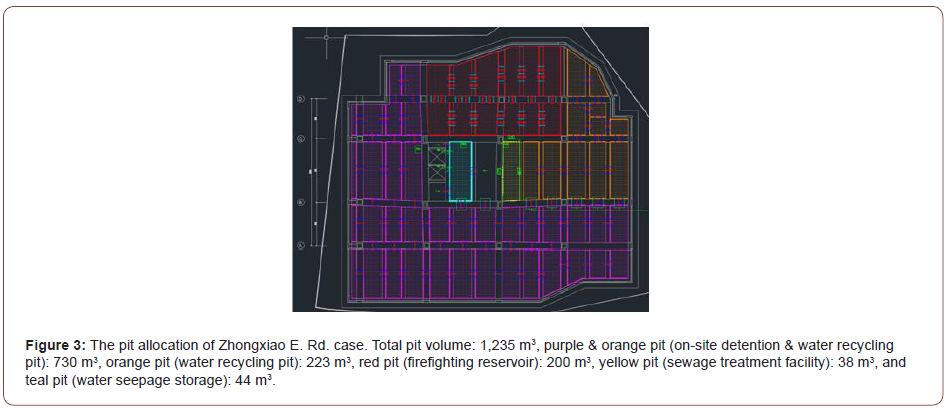 Opinion
Opinion
Unused Raft Foundation Spaces as Detention Ponds to Mitigate Urban Flooding
Chi-Feng Chen, I-Ting (Tim) Chen and Jen-Yang Lin*
National Taipei University of Technology, Taiwan
Jen-Yang Lin, Department of Civil Engineering, National Taipei University of Technology, Taipei City, Taiwan.
Received Date: May 23, 2022; Published Date: June 02, 2022
Abstract
Urbanization is changing the original catchment properties which are altering the urban hydrology. With increased impermeable pavements, including buildings and roads leading to less infiltration and more runoff during precipitation comes with the upsurge in urban flooding frequency. To mitigate urban flooding, onsite source control measures integrated with existing drainage systems are widely used. The onsite source control is aimed to increase the ability of infiltration and detention to decrease and delay the surface runoff. In addition to building a new structure, the existing and unused raft foundations in buildings can be utilized to detain excess runoff. This study investigated 4 buildings in Taipei City, Taiwan, and found that raft foundations show high potential as an onsite detention method. The legislated minimum water detention is 0.078 m3 per square meter of the construction area (m2); however, the average of 0.23 m3/m2 can be achieved when an unused raft foundation is employed. Under this possible scenario, the flood mitigation capacity of Taipei city can be increased from 78.8 mm/hr to 82.0 mm/hr.
Introduction
Urban development is slowly reshaping the hydrological cycle by altering vegetation, land cover, and topography. Changing these factors without proper management will significantly affect the ways water move through the environment. Impervious surfaces that come with rapid urban development accelerate runoffs to receiving water bodies inducing faster and higher peak flows, coupled with unpredictable rainfall frequency from global warming resulting in a rise in urban flooding. To mitigate the impacts of urban flooding, the low impact development (LID) in the US, sustainable drainage system (SuDS) in the UK, water-sensitive city in Australia and New Zealand are established [1-3]. In these methods, increasing onsite infiltration and storage are the main measures to reduce extra runoff. However, in addition to the nature-based solutions (NBS) [4], the existing raft foundation of buildings can also serve as an alternative measure to detain and store extra runoff.
Taipei city is the capital city of Taiwan and is a highly-dense area. However, Taipei has seen a continuous rise in flooding frequency over the past 10 years. The current Taipei storm drain standard of handling design storm is 78.8 mm/hour. However, from 2011-2021 storms exceeding the capability of the storm drain occurred every year and resulted in urban flooding (Figure 1). To reduce the runoff from construction, a legislated water detention rate in Taipei city was set, which is 0.078 cubic meter (m3) runoff per square meter (m2) of the construction site should be retained on-site and refrained from discharging into the storm drain. The legislated water detention rate is calculated from the following equation:

Taipei is heavily dominated by high rises with raft foundations due to the raft foundation’s ability to provide a watertight construction underneath the foundational level above the groundwater table and act both as a water prevention retaining wall and a basement wall. The area of the raft foundation which sits above the foundational level and below the basement level is interconnected by ground beams which creates vacant space between the vertical and horizontal ground beams called pits. As the pits are typically empty, architects begin to design specific functions for the pits to fulfill different bylaws and regulations. Therefore, this study is aimed to seek a new function for these pits in raft foundations to combat urban flooding. Storm runoffs within the foundational pit of the raft foundation prevent overloading the existing storm drain thereby minimizing flood risk and damages.
Methods
Four cases in Taipei city were assessed to understand how the current on-site detention is applied and how much vacant pit capacity is available to be employed as on-site detention. The descriptions of the cases are summarized in Table 1. The current detention pit volume is the existing volume used to detain runoff, in accordance with the required detention rate, 0.078 m3/m2. Pit spaces within the raft foundation are comprised of firefighting basin, rainwater recycling pond, sewage treatment facilities, and water seepage pond. The total pit volume deducting the current detention volume and other required volume is the extra potential detention capacity. Therefore, the maximum detention pit capacity is the current detention volume plus the potential volume and the potential detention capacity ratio is the maximum volume divided by the total site area (Table 1) (Figures 2, 3).



Table:Basic data of the studied cases and the detention ratio.

To illustrate our method, we took one of the projects listed above as an example below. The Zhongxiao E. Rd. site’s area is 2,152 m2 and the area of the whole block including the outer yellow dash which denotes the center of the street has an area of 5,648 m2 (Figure 2). The total current detention capacity is 730 m3. Based on the regulated detention volume, which is 2,151 m2*0.078 m3/m2=168 m3, the current detention volume meets the legislation standard. The Figure 3 is to visualize the proportion of different usages for the foundational pit in the diaphragm/slurry wall technique in Taiwan.
This project utilizes the Taipei City’s incentive standard for Urban Renewal Planning and Design which specify if the development has double the capacity of regulated minimum on-site detention the development can be awarded an additional 1% of total floor space. Doubling the minimum on-site detention capacity is 168 m3 * 2 = 336 m2. In this project, the construction company utilized the whole 730 m3 as detention capacity in applying for the incentive policy. So that there is no extra volume for potential detention capacity.
Findings
As Taipei implemented the minimum on-site detention regulation in October of 2013 and with approximate 2.5-3 years construction period, we can safely assume projects from 2017 onwards will all have minimum on-site detention. From the table below, the annual new construction area in Taipei city was shown. Under the regulated detention ratio, a total of 4,048,850 m3 detention capacity were provided in the 5 years to detain rainwater. When applying the suggested ratio, an additional 5,652,222 m3 capacity could be provided. This implied that close to 3 times the volume can be used for rainwater detention in the building’s raft foundations compared to the current state (Table 2).
Table 2:Basic data of the studied cases and the detention ratio.

Assuming the additional capacity is evenly distributed within Taipei city, the additional capacity divided by the total area of Taipei city can give us an approximate depth for absorbing additional storm runoff. This means that the additional detention capacity provided by the raft foundation could help to soak up rainfall and enhance the current flood mitigation ability. Figure 4 shows that the transformation from additional detention volume to rainfall intensity, and the accumulative volume in 2021 could provide an additional 3 mm incremental rainfall depth ability (Figure 4).

Conclusion
This research shows by increasing the current minimum onsite detention capacity with unused raft foundation is possible. Current projects show that doubling to tripling the current Taipei’s standard for minimum on-site detention is feasible thus instead of building a new detention facility, fully utilizing the vacant foundational pits of buildings for potential detention capacity could be an alternative measure in reducing urban flood risks.
Acknowledgment
None.
Conflict of Interest
None.
Conflict of Interest
No conflict of interest.
References
- Bae C, Lee DK (2020) The effects of low-impact development practices on flood events in a highly developed urban area are at the catchment scale. Int J Disaster Risk Reduct 44: 101412.
- de Macedo MB, Gomes Júnior MN, de Oliveira TRP, Giacomoni MH, Imani M, et al. (2020) Impact Development practices in the context of United Nations Sustainable Development Goals: A new concept, lessons learned and challenges. Critical Reviews in Environmental Science and Technology, Crit Rev Environ Sci Technol 52: 2538-2581.
- Fletcher TD, Shuster W, Hunt WF, Ashley R, Butler D, et al. (2015) SUDS, LID, BMPs, WSUD and more – the evolution and application of terminology surrounding urban drainage. Urban Water J 12: 525–542.
- Huang Y, Tian Z, Ke Q, Liu J, Irannezhad M, et al. (2020). Nature‐based solutions for urban pluvial flood risk management. Wiley Interdisciplinary Reviews: Water, 7(3): e1421.
-
Chi-Feng Chen, I-Ting (Tim) Chen and Jen-Yang Lin. Unused Raft Foundation Spaces as Detention Ponds to Mitigate Urban Flooding. Cur Trends Civil & Struct Eng. 8(5): 2022. CTCSE.MS.ID.000697. DOI: 10.33552/CTCSE.2022.08.000697.
-
Buildings, Roads, Hydrology, Global warming, Urban flooding, Raft foundation, Flood risks
-

This work is licensed under a Creative Commons Attribution-NonCommercial 4.0 International License.






